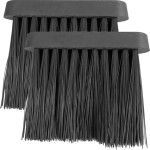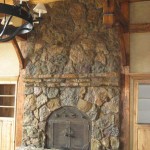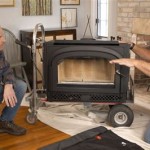The Enduring Appeal of Vintage Fireplace Surround Tile
Vintage fireplace surround tile holds a unique position in the realm of architectural salvage and interior design. It represents not just a decorative element, but a tangible connection to past eras, reflecting the aesthetic sensibilities, manufacturing techniques, and social contexts of its time. The resurgence in popularity of these tiles stems from a desire to incorporate character, craftsmanship, and historical depth into contemporary living spaces.
The term "vintage" typically encompasses tiles produced from around the early 20th century to the mid-20th century, often characterized by distinct Art Deco, Arts and Crafts, or Mid-Century Modern design principles. These tiles were often crafted with meticulous detail, employing techniques and materials that are less common in modern mass production. Consequently, they possess a unique patina and inherent imperfections that contribute to their charm and authenticity.
The selection of vintage fireplace surround tile requires careful consideration of several factors, including the tile's origin, condition, design, and intended application. Understanding the history and characteristics of different tile styles is essential for making an informed decision and ensuring a cohesive integration with the overall design aesthetic of the room.
Identifying and Appreciating Different Tile Styles
Several distinct styles of vintage fireplace surround tile have emerged throughout history, each reflecting the artistic and technological advancements of its era. Recognizing these styles is crucial for accurate identification and appreciation of their unique characteristics.
Art Deco Tiles: This style, popular from the 1920s to the 1940s, is characterized by geometric patterns, stylized floral motifs, and bold colors. Art Deco tiles often feature streamlined designs, reflecting the era's fascination with modernity and industrial progress. Common colors include black, white, gold, and vibrant jewel tones. These tiles may incorporate metallic accents or relief patterns, adding depth and visual interest. The patterns often emphasize symmetry and repeated motifs for a striking visual impact.
Arts and Crafts Tiles: This style, prevalent from the late 19th century to the early 20th century, emphasizes handcrafted quality, natural materials, and organic motifs. Arts and Crafts tiles often feature earthy tones, such as browns, greens, and muted blues. Common designs include stylized flowers, leaves, and animals. These tiles may exhibit variations in color and texture, reflecting the handmade nature of their production. Glazes are typically matte or semi-matte, contributing to a rustic and understated aesthetic. Some Arts and Crafts tiles might be hand-painted or feature embossed designs, adding to their individuality.
Mid-Century Modern Tiles: Emerging in the post-World War II era, this style is characterized by clean lines, geometric shapes, and a focus on functionality. Mid-Century Modern tiles often feature bright colors, such as turquoise, avocado green, and mustard yellow. Abstract patterns and minimalist designs are common. These tiles may be made from ceramic, porcelain, or other durable materials. The emphasis is on simplicity and practicality, reflecting the era's optimistic outlook and technological advancements. Some Mid-Century Modern tiles incorporated bold geometric designs or playful abstract patterns to add a sense of visual interest.
Beyond these primary styles, other variations exist, including Victorian tiles with intricate patterns and elaborate detailing, and Spanish Revival tiles with vibrant colors and Moorish-inspired designs. Understanding the nuances of each style allows for a more informed appreciation of the tile's historical and artistic significance.
Assessing the Condition and Sourcing Vintage Tiles
The condition of vintage fireplace surround tile is a critical factor to consider before making a purchase. Due to their age and previous use, these tiles may exhibit signs of wear and tear, such as cracks, chips, stains, and fading. A thorough inspection is essential to assess the extent of any damage and determine the feasibility of restoration or repair.
Minor imperfections, such as small chips or hairline cracks, may be acceptable and even contribute to the tile's vintage character. However, more significant damage, such as large cracks, missing pieces, or extensive staining, may compromise the tile's structural integrity and aesthetic appeal. It is important to carefully evaluate the severity of any damage and determine whether it can be addressed through professional restoration techniques.
Sourcing vintage fireplace surround tile requires patience and diligence. Several avenues are available, including architectural salvage yards, antique stores, online marketplaces, and specialized tile dealers. Architectural salvage yards typically offer a wide selection of reclaimed materials, including vintage tiles, often at competitive prices. However, the selection may be inconsistent, and the condition of the tiles may vary.
Antique stores and online marketplaces offer another option for sourcing vintage tiles. These sources may provide a more curated selection of tiles, with detailed descriptions and photographs. However, prices may be higher than those found at architectural salvage yards. Specialized tile dealers often focus exclusively on vintage and antique tiles, offering expert knowledge and a wide range of styles and designs. These dealers may also provide restoration and repair services, ensuring the tile's longevity and aesthetic appeal.
When sourcing vintage tiles online, it is recommended to carefully examine the photographs and descriptions provided by the seller. Request additional information or photographs if necessary, and inquire about the seller's return policy. It is also advisable to research the seller's reputation and read customer reviews before making a purchase.
Installation and Maintenance Considerations
The installation of vintage fireplace surround tile requires careful planning and execution to ensure a successful and aesthetically pleasing result. It is recommended to hire a qualified tile installer with experience working with vintage materials. These professionals possess the knowledge and skills necessary to handle delicate tiles, prepare the substrate properly, and achieve a seamless and durable installation.
Before installation, the existing fireplace surround should be thoroughly cleaned and prepared. Any loose or damaged mortar should be removed and replaced. The substrate should be level, smooth, and structurally sound to ensure proper adhesion of the tiles. Depending on the type of substrate, it may be necessary to apply a waterproofing membrane or a cement backer board to protect the tiles from moisture damage.
When laying the tiles, it is important to maintain consistent spacing and alignment. Use spacers to ensure uniform grout lines. Consider the overall design and pattern of the tiles, and plan the layout carefully to achieve a balanced and visually appealing arrangement. If necessary, cut the tiles to fit the dimensions of the fireplace surround, using a wet saw or tile cutter.
Once the tiles are installed, allow the mortar to cure completely before applying grout. Choose a grout color that complements the tiles and enhances their overall aesthetic. Apply the grout evenly and carefully, using a grout float to press it into the joints. Remove any excess grout with a damp sponge. After the grout has cured, seal the grout lines to protect them from stains and moisture damage.
Maintaining vintage fireplace surround tile requires regular cleaning and occasional restoration. Avoid using harsh chemicals or abrasive cleaners, as these can damage the tile's surface. Instead, use a mild detergent and a soft cloth to clean the tiles as needed. For stubborn stains, consider using a specialized tile cleaner or a paste made from baking soda and water. If the grout lines become stained or discolored, use a grout cleaner or a bleach solution to restore their original appearance.
Periodically inspect the tiles for any signs of damage, such as cracks, chips, or loose pieces. Repair any damage promptly to prevent further deterioration. If necessary, hire a professional tile restorer to repair or replace damaged tiles. With proper care and maintenance, vintage fireplace surround tile can provide enduring beauty and historical significance to any home.

Fireplace Architectural Tile Handmade Vintage Historic
Fireplace Tile Surround 5 Decorative Mantel Tiles 2024

Fireplace Architectural Tile Handmade Vintage Historic

Fireplace Architectural Tile Handmade Vintage Historic
Fireplace Tile Surround 5 Decorative Mantel Tiles 2024

Interior Design San Francisco Heath Tile Fireplace Home Vintage Surround

Fireplace Architectural Tile Handmade Vintage Historic

Pin By Philadelphia Salvage On Vintage Tile Fireplace Victorian Tiles Bookshelves
/102661017-6a23c040b71843379188b96b21ac1a08.jpg?strip=all)
How To Tile A Fireplace

Antique Fireplace Fronts Sa1969 Blog Tile Simple Vintage








